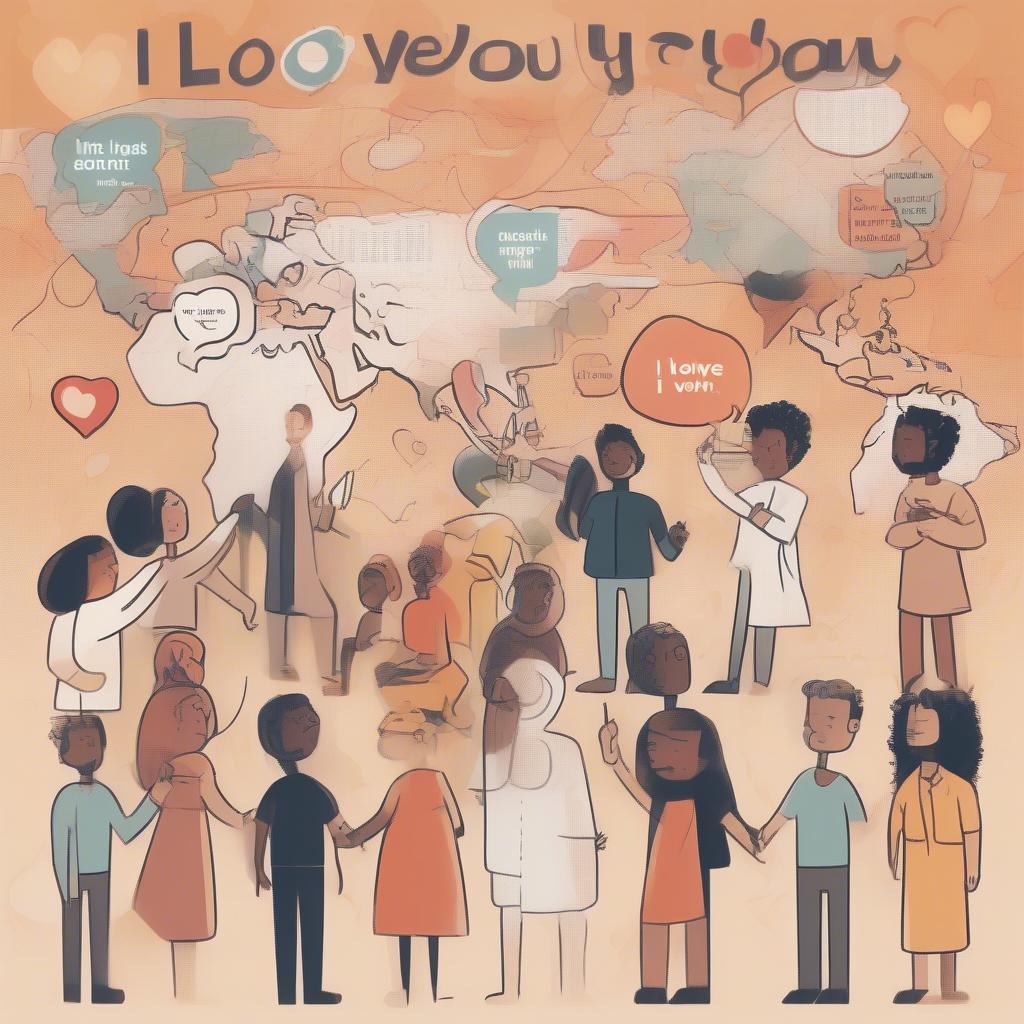Learning how to say “love” in different languages can be a beautiful way to connect with people from around the world and express your affection in a unique and meaningful way. Whether you’re traveling, connecting with someone special, or simply curious about different cultures, knowing how to express love transcends linguistic barriers.
 Expressing Affection Across Cultures
Expressing Affection Across Cultures
Expressing Affection: More Than Just Words
Saying “I love you” is a significant step in any relationship. But what if you want to express those feelings in a language other than your own? Exploring How To Say Love In Many Languages offers a glimpse into different cultures and their expressions of affection. It’s more than just memorizing words; it’s about understanding the cultural nuances and emotional weight they carry. For example, while “te amo” is commonly used in Spanish-speaking countries, the intensity and frequency of its use can vary regionally. Similarly, in some cultures, non-verbal cues like gestures and physical touch may play a more significant role in expressing love than spoken words.
Why Learn to Say Love in Other Languages?
Learning how to say love in many languages can enrich your understanding of global cultures and strengthen your connection with others. It allows you to express yourself in a way that resonates deeply with someone who speaks another language, showcasing your effort and thoughtfulness. Imagine the joy on someone’s face when you tell them you love them in their native tongue! It can be a deeply touching gesture that fosters deeper connections. cómo se escribe love you offers further insights into expressing love in Spanish.
A World of Love: Exploring Different Expressions
Here’s a glimpse into how to say love in several languages:
- French: “Je t’aime” (zhuh tem) – This classic expression is known worldwide for its romantic flair.
- Spanish: “Te amo” (tay ah-moh) – A passionate declaration of love commonly used in Spanish-speaking countries.
- Italian: “Ti amo” (tee ah-moh) – Similar to Spanish, Italian also uses “ti amo” to express deep affection.
- German: “Ich liebe dich” (ish lee-buh dikh) – A heartfelt expression often reserved for close relationships.
- Japanese: “愛してる” (aishiteru) – While less frequently used than other expressions of affection in Japanese, “aishiteru” signifies deep and abiding love.
 Global Expressions of Love
Global Expressions of Love
Navigating Cultural Nuances
While learning the words is important, understanding the cultural context is crucial. For example, in some cultures, public displays of affection are common, while in others they are considered inappropriate. Being mindful of these cultural differences ensures your expressions of love are received as intended. how he love sus explores different ways to show love, beyond just verbal expressions.
Beyond “I Love You”: Other Ways to Express Affection
While “I love you” is a powerful phrase, there are many other ways to express affection in different languages. Learning terms of endearment, compliments, and phrases that convey care and concern can add depth and richness to your communication. how do you say i love you dad in spanish provides specific guidance on expressing love to family members.
 Non-Verbal Communication of Love
Non-Verbal Communication of Love
Expert Insight: Dr. Isabella Rossi, a renowned linguist and cultural anthropologist, emphasizes the importance of cultural sensitivity when expressing love in different languages: “While translating ‘I love you’ might seem straightforward, understanding the cultural context in which these words are used is essential for genuine communication.”
Expert Insight: Dr. Liam O’Connell, a relationship expert and author, adds, “Learning to express love in your partner’s native language is a powerful gesture that demonstrates deep care and respect.”
In conclusion, learning how to say love in many languages is a beautiful way to connect with others and express your affection in a meaningful and culturally sensitive way. It opens doors to cross-cultural understanding and strengthens bonds between people. So, embrace the diversity of languages and express your love to the world!
FAQ:
- What is the most common way to say “I love you” in French? (Je t’aime)
- How do you say “I love you” in Italian? (Ti amo)
- Is “aishiteru” used frequently in Japanese? (No, it’s reserved for serious expressions of love.)
- Why is cultural context important when expressing love in different languages? (To avoid misunderstandings and ensure your message is received as intended.)
- What are some other ways to express affection besides “I love you”? (Terms of endearment, compliments, expressions of care and concern.)
- What is the significance of learning how to say “love” in other languages? (It promotes cross-cultural understanding and strengthens relationships.)
- How can I learn more about expressing love in specific languages? (Through online resources, language learning apps, and cultural immersion experiences.)
Need support? Contact us via Email: contact@daiduongtranhba.com, or visit our office at Michigan Ave, Suite 3100, Chicago, IL 60611, USA. Our customer service team is available 24/7.

